Source: WTL photo© on site in Mexico City, 2008.
Image: The capilla churrigueresca alongside the Catedral Metropolitana. For additional views of this famous architectural façade, see: => Mexico City #6; => Mexico City #6b; and => Mexico City #6c.
Comments: The first close-up view of the façade. José Benito de Churriguera (1665-1725) and his sons developed this style you see here, which is the most "extreme and extravagant" of all Baroque styles; hence, Churrigueresque. Among the features of this style are "Solomonic columns" (twisting spiral like a corkscrew) and "composite or supreme order" (mixed styles of the top part of the column, thought to give a very delicate effect). In the early 18th century, for those architects within the late Baroque tradition, the Churrigueresque column (basically, an inverted cone) was the dominant aspect of decoration and ornamentation. However, notice that by the time the Spanish-Mexican architect of this chapel, Lorenzo Rodríguez, designed this chapel, most of the Eurocentric world had already moved on to Neoclassical style. Compare, for example, the following church in Brazil: São Francisco de Assis, in Ouro Preto, Brazil.
Humanities topic: After comparing the style of the façades of both churches (Sagrario Metropolitano in Mexico and São Francisco de Assis in Brazil), write a short paragraph speculating on reasons that may explain the preference for the different styles in these two different places in Latin America during the same century of the Common Era calendar: i.e., the 18th century C.E.

